Bednorz W. (ed.) Advances in Greedy Algorithms
Подождите немного. Документ загружается.

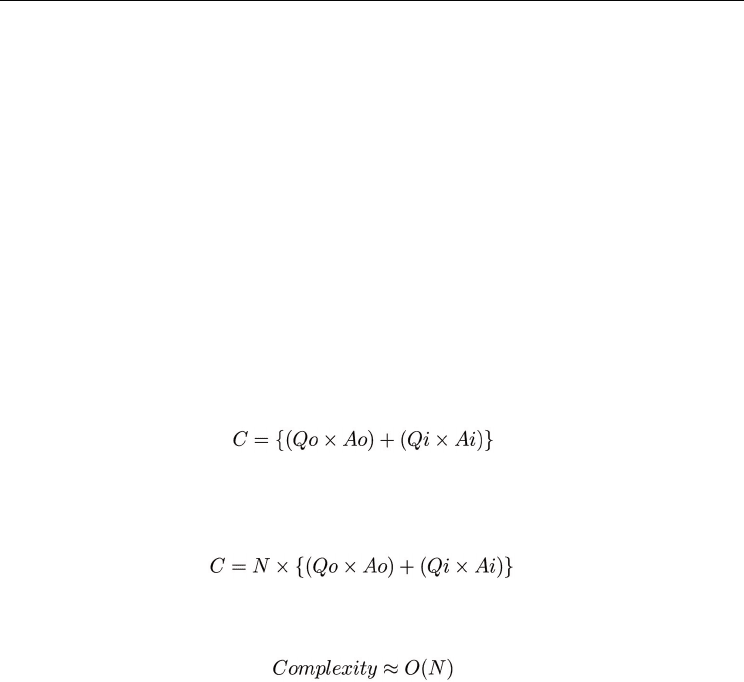
Semantic Matchmaking Algorithms
491
• Theatre is super class of Drama→ Exact match
• ” Music subsumes Concert → Plugin match
Overall degree of matching for Query and Advt is Plugin. If we have changed order of
concepts in Query
outputlist
, we could have achieved this matching. Thus, algorithm in [12] is
dependent on the order in which concepts are defined. Thus, algorithm may produce false
negative results.
Consider the scenario when the output concept is not removed from the candidate list.
Suppose, the advertisement is for {Theatre, Cost} and the request is for {Drama, Concert}.
Here, the above algorithm would return an exact match as both Drama and Concert are
immediate subclasses of Theatre. Hence, the requester would receive only one reservation for
a Theatre whereas he expected two reservations for a Drama and a Concert. This would result
in a false positive.
4.1.2 Quantitative analysis
For each advertisement, we have to compare each output concept of query with all the
advertisement concepts and each input concept of advertisement to all the input concepts of
query. Hence, the number of operations are given by
(3)
where Qo and Ao are the number of output concepts and Qi and Ai are the number of input
concepts in query and advertisement respectively. Since, the algorithm iterates over N
advertisements, the total complexity is given by
(4)
in general, Qo,Ao,Qi and Ai are bounded by small integers. Hence, the complexity is linear
in N (the number of advertisements) with small constants.
(5)
4.2 Bipartite graph based matching
To solve the problems mentioned in previous section, we introduce in this section another
approach [5] towards semantic matchmaking which makes use of bipartite graph matching
to produce a match.
The algorithm also introduces a different set of rules of match between concepts in which
PlugIn and Subsume levels are interchanged in their degree of match. The assumption that
if an advertiser advertises a concept, it would provide all the immediate subtypes of that
concept is dropped. Hence, if the query concept is subsumed by the advertisement concept a
Subsume is returned while if the query concept subsumes the advertisement concept
PlugIn is returned. PlugIn is still ranked higher than a Subsume match. You can see that
this scheme of matching is opposite to the one discussed in previous section.
Bipartite graph A bipartite graph is a graph in which the vertex set can be divided into two
disjoint sets such that no edge of the graph lies between the two vertices in the same set.
Matching A matching of a bipartite graph G = (V,E) is a subgraph G’ = (V,E’) such that no
two edges e1,e2 in E’ share the same vertex.
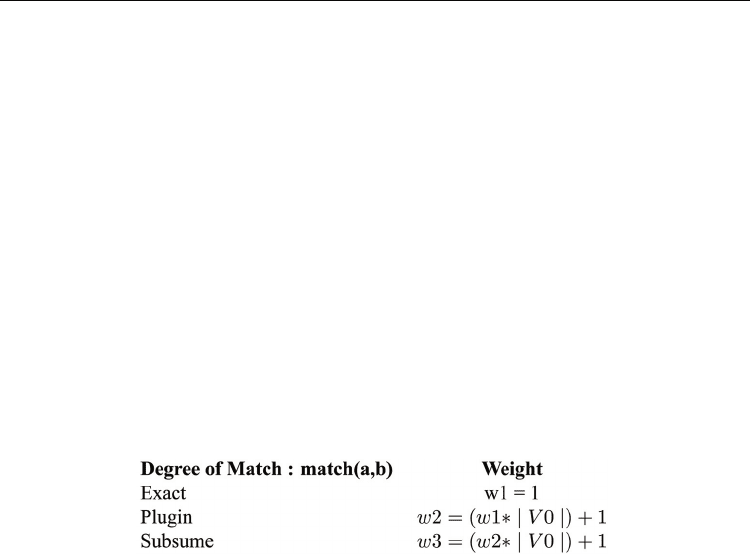
Advances in Greedy Algorithms
492
Let the set of output concepts for query and advertisement be Q and A. We will construct a
graph G = (Q+A,E) which has one vertex corresponding to each concept in query and
advertisement . If there exists a degree of match between (≠ Fail) between a concept v1
belonging to Q and a concept v2 belonging to A, then we define an edge (v1, v2) with weight
as the degree of match. We need a matching in which all the output concepts of Q are
matched with some concept of A. If such a matching exists, we would say that the
advertisement and the query match.If there exist multiple such matchings, we will choose
the one which is optimal(the criterion is defined below). However, if such a matching
doesn’t exist the query and the advertisement doesn’t match.
optimality criterion We need to select the matching which is best from the perspective of
semantic match. For, this we would assign different numerical weights to edges with
different degrees of match. Let us suppose, we assign minimum weight to exact, then
Plugin and then subsumes.Let max(wi) be the maximum weighted edge in the matching. An
optimal matching in this case would be a complete matching with minimum max(wi).
Algorithm for optimal matching Hungarian algorithm [10] computes a complete matching
for a weighted bipartite graph such that sum of weights of all the edges in the matching is
minimised. To adapt Hungarian algorithm to above case, where a matching with minimum
value of max(wi) is needed, we would assign weights according to the scheme shown as
below.
It can be proved that with the above weighting scheme, a matching in which Σwi is
minimized is equivalent to matching in which max(wi) is minimised [5].
Matchmaking Algorithm The search procedure accepts a query as input and tries to match
its output concepts and input concepts with each advertisement. If there exists a match in
both input and output concepts, it appends the advertisement to the result set. To match
inputs as well as it outputs, it invokes Hungarian algorithm on a graph created with weights
as given in above table to compute an optimal matching of the graph. The degree of match is
defined by the weight of the maximum-weight edge in the matching. In the end, a list of
advertisements sorted on the basis of input and output concepts is returned.
4.2.1 Discussion
The above algorithm eliminates the correctness issues with the algorithm described in the
previous section. It also regulates false positives and false negatives as discussed in the
example above. However, it does not allow for priority of concepts and soft constraints to be
input by the user. Like the previous algorithm, the algorithm does not provide a ranking of
the results. The algorithm assumes a shared ontology between the advertisements and the
request. In the following sections, we would look at some algorithms which allow some of
these features.
4.2.2 Quantitative analysis
Using the same notation as in Section 4.1.2, we get
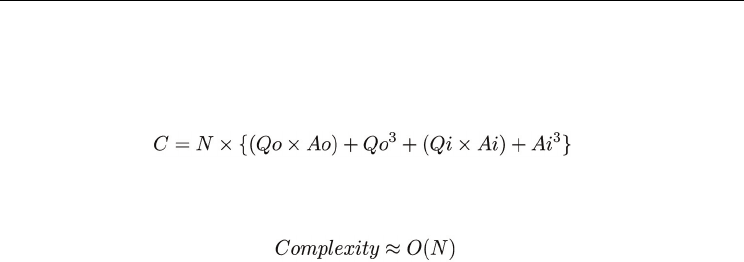
Semantic Matchmaking Algorithms
493
The weights wo, w1 and w2 are computed in O(1) time. The weights of edges in the graph
can be determined in Qo×Ao operations, by comparing all pair of concepts.
The time complexity of Hungarian algorithm is bounded by Qo
3
. Hence, the total complexity
of the search is bounded by:
(6)
Hence, we get If we assume that number of input and output concepts in the query and
advertisement are small, we can approximate:
(7)
The complexity of above algorithm is asymptotically similar to the previous algorithm.
However, the constants will be different.
4.2.3 Addition of precondition and effect matching
Original algorithm proposed by [5] was based on matching of input and output terms only.
However, precondition and effect matching can also be added using same bipartite graph
based technique as discussed in [6]. As discussed earlier, in OWL-S description,
preconditions and effects are represented as boolean expression. Algorithm for condition
matching works in two phases.
• Parameter Compatibility: Whether parameters used in both expressions are equivalent
or not. From input-output terms matching, we obtain the mapping between terms used
in query and advertisement. If every parameter used in the query’s condition has an
equivalent parameter (obtained from the mapping constructed during input-output
term matching phase) in the advertisement’s condition such that, degree of matching
between two parameters > Fail Match, we have parameter compatibility between these
two conditions.
• Condition Equivalence: This refers to structural similarity between two conditions. For
our purpose, we do not need strict equivalence. If condition specified in the query
contains all parameters specified in advertisement’s condition AND the relation
between various parameters in advertisement’s condition are retained in query
condition, we can flag it as condition equivalence. In other words, if condition in the
query is denoted by QCondition and condition in advertisement is denoted by
ACondition then what we need is,
QCondition ⇒Acondition
which essentially says that, variable space in which QCondition is true is a subset of the
variable space in which ACondition is true.
This is true when we match for preconditions. The relation will be reversed when we
match for effects. i.e.
ACondition ⇒ Qcondition
This problem is constraint satisfiability problem which NP-Complete by its nature.
Some heuristics like DPLL algorithms are used to solve this problem in exponential
time.
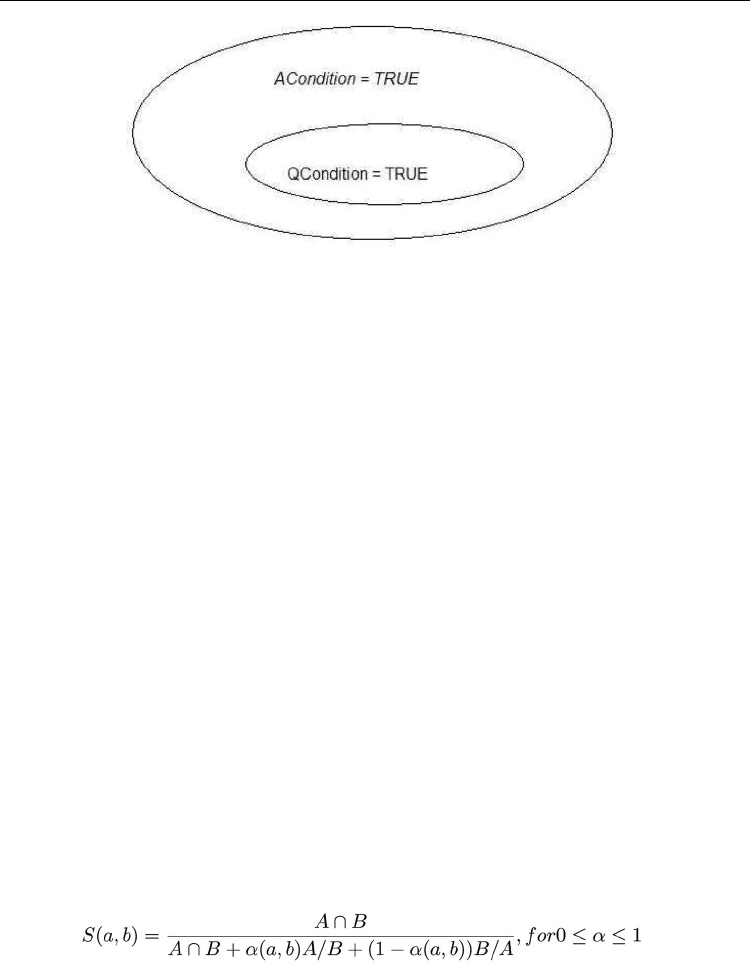
Advances in Greedy Algorithms
494
Fig. 5. Solution space for ACondition and Qcondition
4.3 Semantic matchmaking across heterogeneous ontologies
In this section, we discuss a framework for semantic matchmaking which relaxes the
requirement of a single ontology and allows advertisements and requests to be expresses in
different ontologies. The approach to compare concepts across ontologies uses different ways to
assess the similarity of various concepts used in description of services and requests [14].
SynonymSets Synonymsets are semantically equivalent or very similar words. Hence,
synonyms can be considered as the same entity. Wordnets are used to derive the synonym
set of the name of the parameters. In a cross-ontology evaluation scenario these words(like
person and human) are likely to refer to the same entity.
Distinguishing features of concepts Some concepts could have quite different names, while
still being semantically similar. To incorporate semantics into the similarity measure in such
cases we can also use some distinguishing features of concepts. We choose the properties of
classes such as object properties and data type properties to perform semantic similarity
tests. The assumption is that semantically similar parameters with different names are likely
to have some common features or properties. The matching is performed between the
properties of the two concepts.
Semantic neighbourhoods and relations The semantic relations which exist between
various classes could be used to perform semantic matchmaking. The idea is that the target
concepts (i.e.which are subject of comparison) which are related to the same set of classes
through similar relations, may be semantically similar. For example, semantic relations like
Subclass, Disjoint With,Equivalent Classes etc. can help determine semantic similarity
amongst various concepts.
To integrate the information obtained by above methods, a weighted sum of the similarity
of each function component is used to compute the overall similarity.
Another similarity measure defined in terms of set theory is based on the normalisation of
Tversky’s model and the set-theory functions of intersection(A ∩ B) and difference (A/B). It
is shown below.
(8)
where a and b are parameter classes
A and B corresponds to the description sets of a and b
(i.e. synonym sets,feature sets and semantic neighbourhood)
and is a function which defines relative importance of non-common characteristics

Semantic Matchmaking Algorithms
495
The above mentioned similarity measures are used to compute the edge weights of edges in
the bipartite graph discussed in the previous section. The function elements( concepts) are
extracted from the advertisement as well as the requested profile. A bipartite graph is
formed using these concepts as nodes. The edge weights are then computed using the
similarity measures described above. Bipartite graph matching algorithms are then applied
to produce matches and their scores which are used to generate the sorted list of relevant
advertisements.
4.3.1 Discussion
The algorithm provides a way to make semantic matchmaking possible over descriptions
with heterogeneous ontologies. The algorithm uses a similarity function of concepts for
matching which is based on a weighted sum of synonym sets,semantic neighbourhood and
distinguishing features. The algorithm however does not allow the user to input preferences
of concepts. Preference of concepts would give the requester more expressive power to
express their needs. In further sections, we would look into some algorithms which support
preferences amongst the concepts.
4.4 Semantic matchmaking based on description-logics
We now discuss an algorithm which performs semantic matchmaking on advertisements
and requests which are defined in Description Logics. Description Logics(DL) are a family
of logic formalisms used for knowledge representation. They can be used to represent the
knowledge of a service or an application domain in a structured and formal way which can
be understood by a computer system. As we will see the algorithm discussed below
provides a ranking of the matched advertisements which was not the case with the previous
algorithms.
In this section, we’ll discuss an algorithm for the DL of the Knowledge Representation
System CLASSIC of AT&T Bell Labs [15]. The basic syntax is based on predicate logic and
comprises of three kinds of descriptions.
• concept names concept names stand for sets of objects, such as book, room etc.
• number restrictions these correspond to restrictions which quantify the amount of a
concept. for example, (> 3author) denotes that there should be more than three authors.
• universal quantifications these can be used to specify some restriction on all the objects
belonging to a concept. For example, ∀ supplier.japanese implies that all the suppliers
(i.e.objects belonging to the concept supplier) must be Japanese.
An advertisement (as well as a request) can be described as a conjunction of these concepts.
For example, one might represent an advertisement for an apartment as
A = apartment ∩ ∀hasRooms.roomswithTV ∩ (≥ 3 hasRooms)
Requests can be represented in the similar way. The matchmaking algorithm then matches
the request with the candidate advertisements one by one and provides a ranking for the
match.The algorithm, recursively calls itself for the parts which are universally quantified
and keeps a global score which denotes the degree of match. If there happens to be a case, in
which there exists a universal quantification statement for a particular concept in only one
of the advertisement or request, the recursive call is made with a T (universal truth) as
predicate. Hence, if a description does not mention ∀hasRooms, we would assume that
∀hasRooms.T is present in the description. The algorithm is as follows.

Advances in Greedy Algorithms
496
4.4.1 Algorithm
The algorithm for ranking follows a recursive procedure as mentioned above. It starts with a
global rank of zero for every advertisement and then increases it for every concept which
differs in the advertisement and the request. Therefore, lower the rank, higher is the degree
of match. The algorithm uses four rules to increase the rank which are given below :-
• Add 1 to rank for each concept name which are present in query but not in
advertisement
• Add 1 to rank for each number restriction in request which can not be satisfied by the
advertisement
• If for a concept ∀R.E, there does not exist a ∀R.F in the advertisement, add to rank the
answer to the recursive call with T, and E.
• If for a concept ∀R.E, there does exist a ∀R.F in the advertisement, add to rank the
answer to the recursive call with F, and E.
Total match exists when the algorithm returns 0. The above algorithm can be modified
easily to provide for preference of concepts. By adding different weights for different
concepts, we can penalize the match selectively according to our preferences. Thus, an
important concept would cause a larger number to be added to n, hence decreasing the
degree of match for advertisements which can not satisfy them. In the next section, we will
see how preference of concepts can increase your expressive power in defining the query.
The taxonomy can be also taken into account, while defining weights for various concepts.
Hence, in the taxonomy of figure 2.1, we could say that n will be increased a larger amount
if we have vehicle and SUV as compared to if we have vehicle and cars. The weights can
also be learnt by the system, by providing a set of advertisements and their ranks according
to human users. Hence, the system would be able to learn to distinguish between concepts
which are more important by learning weights to fit given training examples of ranked
advertisements.
4.4.2 Discussion
In this section we saw an algorithm which performs semantic matchmaking on
advertisements and requests described using Description Logics. As we discussed, the
algorithm performs an approximate matching of advertisements and requests and provides
a ranking of candidate advertisements with varying degrees of match. The algorithm can
also be used to take into account preference of concepts as provided by the user.
4.5 Semantic matchmaking based on ranked instance retrieval
In this section we present another method for semantic matchmaking which takes into account
the preference of concepts a provided by the user [4].This algorithm uses the concept of a
ranking tree to match and compare various advertisements w.r.t. a particular query.
We will take an example to describe how the preference of concepts gives you more
expressive power in making the request. Suppose, the user wants to find out a service which
offers DVD’s for movies. Hence she could make a query like, Q1 := OffersDVD. However,
this would provide tons of hits. To narrow down our search, she would want to provide
more search criterion. Suppose she specifies that she prefers 24 hours shipping over three-
day shipping and a service with shipping time more than three days is not acceptable.
In this case, writing a query like Q2 := OffersDVD
⊓ (24HoursShipping ⊓ 3DaysShipping),
would get unacceptable results as the proper requirement has not been expressed. To

Semantic Matchmaking Algorithms
497
express the correct requirement, there should be a way to annotate the concepts with
preferences, thus providing a way to determine which concept is preferred. Hence, if we
provide a query like Q3 :=OffersDVD
1
⊓(24HoursShipping
2
⊓ 3DaysShipping
1
), the service with
24HoursShipping would be rated more than 3DaysShipping and hence would generate
acceptable results.
The above method of annotating preferences, could also be used to specify soft constraints
as discussed earlier. Suppose, we have a top concept T, such that every concept is an
instance of type T. Now, suppose if we need to specify that we would prefer to have a
service with CreditCardPayment, however its not a necessity, we could do that by writing
the query as
Q4 :=OffersDV D
1
⊓ (24HoursShipping
2
⊓ 3DaysShipping
1
) ⊓ (CreditCardPayment
1
⊔ T
0
).
Similarly, we could use a bottom concept ⊥ to denote the fact that OffersDVD is a necessary
concept but should not affect the ranking.Suppose we write our query as,
Q5 :=OffersDV D
1
⊔ (24HoursShipping
2
⊔ 3DaysShipping
1
) ⊔ (CreditCardPayment
1
⊔ ⊥
0
).
In the above query, the second part of disjunction is not satisfiable and hence every hit must
satisfy OffersDVD. Hence, ranking is only affected by the other concepts which could be
taken into account by the matchmaking algorithm. Therefore, as we discussed allowing
annotations of concepts with their preferences could give us a lot more expressive power in
describing our request. It will also allow the user to specify soft constraints and constraints
like in Q5.
Due to existence of disjunctive knowledge in description logics (in query Q5), a single
numerical value is not sufficient for expressing rankings. Suppose, we have Q := A
1
⊔(B
1
⊔
C
2
)
0
. Since, B ⊔ C has preference 0, it should not contribute to the top level rank. However,
for two equal top level ranks, we should use (B
1
⊔ C
2
)
0
to refine the ranking. A ranking tree is
appropriate for such kind of reasoning.In the following part of this section, we will discuss a
ranking tree and how it can be used for matchmaking of advertisements and requests with
such annotations.
4.5.1 Ranking tree
We define a ranking tree as follows:
1. for r ∈ [0 ; 1] (r) is a ranking tree.
2. let r ∈ [0 ; 1] and t1,t2 .. tn be ranking trees with n ≥ 1, then (r,t1,t2,...,tn) is a ranking
tree.
for example t1:= (0,(1), (0,(1),(0))) is ranking tree.
Ordering on ranking tree Let a = (r
a
, a1, a2, a3....an) and b = (r
b
, b1, b2, b3.....bn) where
a1,a2...an and b1,b2 ... bn are ranking trees.
Let a < b⇔r
a
< r
b
now, a b iff
1. a < b or
2. r
a
= r
b
and ∃i : a
i
< b
i
and ∀1 ≤ j ≤ n : b
j
≮ a
j
or
3. r
a
= r
b
and ∀1 ≤ i ≤ n : a
i
b
i
4.5.2 Matchmaking algorithm
Given an annotated query and an advertisement, we must evaluate the ranking tree of the
advertisement. The query is represented as either a conjunction or disjunction of subqueries.

Advances in Greedy Algorithms
498
The ranking tree is evaluated by calling the routine recursively for each subquery and using
the resulting ranking trees to form the top-level ranking tree. The rank of top-level rank tree
is an of average user preferences of all the subqueries which are satisfied. For a negated
query, the rank of top-level tree is replaced by the average of user preferences of all the
concepts which are not satisfied by the query. An atomic concept belonging to the query is
satisfied by advertisement if its contained in it.
Discussion The above algorithm supports most of features discussed in chapter 2.The
algorithm supports preference of concepts and allows for soft constraints to be specified. In
the next section, we would look at Quality-of-Service(QoS) aspects of semantic
matchmaking.
4.6 QoS enabled matchmaking
A web service is a web-based interface which providing electronic description of a concrete
service. The service could be of varied types from functionality of a software component
(such as data backup) to a real-life business activity(such as shipping). Hence, the QoS
properties of a service vary over a wide range depending upon the type of service. For
example, for a network service, it could be response-time,availability etc. On the other hand,
for a pizza delivery service it could the quality of food. QoS is a very important factor in
deciding whether the service will be able to fulfil the demands of requester. Hence, it is very
important for a semantic matchmaking algorithm to take into account QoS parameters along
with the functional properties to perform a more meaningful and successful match.
To support QoS information while discovering services through matchmaking process,
we need to evaluate how well a service can fulfil user’s non-functional (quality)
requirements based on the service’s past performance. Hence, there must be an interface
where the users can submit their feedback on the perceived QoS of consumed services.
While discovering services, we can take into account data from the following sources
[11]:-
• QoS values promised by the providers in their advertisements
• feedback on the perceived QoS submitted by the users on the interface
• reports produced by trustworthy QoS monitoring agents such as rating agencies
• QoS information provided by similar discovery components which exist over the
network in a distributed setting
A complementary ontology for providing detailed QoS information have been proposed in
(Semantics in service discovery and management.) Algorithms similar to what we have
studied in this chapter so far, can be applied to perform matching on QoS parameters.
Hence, a service would be matched on its functional properties as well as non-functional
properties and QoS parameters and the information provided by both the aspects would be
combined to provide a common ranking of advertisements which could be used by a
requester.
5. Comparing the algorithms
In this section, we provide, a comparison table comparing the algorithms on various aspects
we have presented so far.
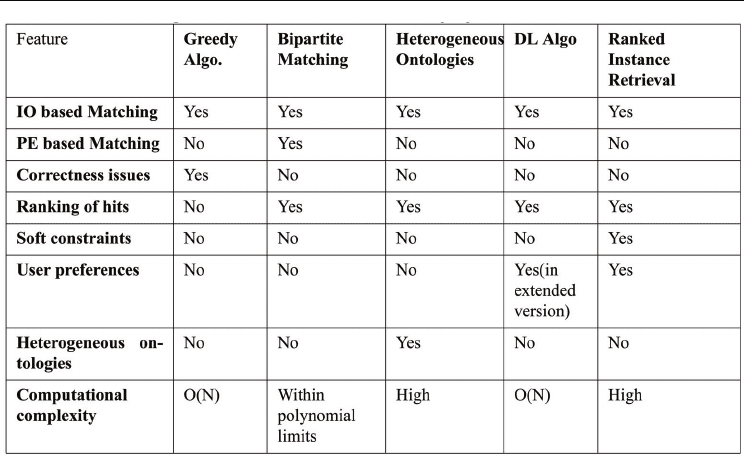
Semantic Matchmaking Algorithms
499
Table 3. Comparison table for different matchmaking algorithms
6. Applications of semantic matchmaking
Semantic matchmaking has been applied in a variety of contexts. It is a very importan field
of research and forms a basis for service discovery and composition. Reliable and efficient
algorithms for semantic matchmaking are extremely important in the new vision of
web(semantic web).
The algorithm we discussed here have been used to make a combined matchmaker for
DAML-S/OWL-S and UDDI. UDDI allows only keyword search based on the names, which
is not enough as no inferencing or flexible matching can be performed. A matching engine
which augments UDDI registries with an additional semantic layer allows for a capability
based matching. It uses the ontologies published on the web. The matchmaking process
allows services to be discovered on the basis of their capabilities and hence result in their
interoperability and enhanced problem solving abilities with minimizing human
intervention.
Preference SQL [9],a powerful extension to SQL aims for providing support for preference
queries in relational databases. Its objective is similar to that of matchmaking. It aims to find
approximate matches to user’s queries which are based on preferences defined by him. It
also performs matchmaking to find the best possible match between a request and existing
data.
OWLS-MX is a semantic web services matchmaker which retrieves services for a given
query. It uses both logic based semantic matching and token-based syntactic similarity
measure to perform the match between a query and the services [13].
[9] discusses the need for semantic matchmaking in geo web services which are in growing
demand these days. Geo Web services are services which provide location based
information on the web. For example, an user who wants to know about hazardous objects

Advances in Greedy Algorithms
500
near her proximity would need to first find out her own location by a geo coder service.
Then she could use another service to locate the all the chemical factories etc near it. With a
semantic matchmaker, such services could be discovered and interoperate with each other
to form more complex services.
[7] use semantic matchmaking approach for skill management of various business entities.
Semantic matching is performed between buyers and sellers of skills. It is very important for
knowledge intensive companies because it can be used to search for professionals who have
expertise in a given area within and across companies.
These are but a few applications of matchmaking engines and algorithms that we have
presented in this chapter.
7. Open issues
We currently do not have well recognized evaluation metrics for the efficiency of algorithms
which would define their scalability in real world scenarios. We also need testcases and
testbeds where various algorithms can be plugged in and tested against each other for
various features described in previous sections.
Currently fuctional information used in semantic matchmaking is limited to IOPE. This can
be extended in the following ways.
• Semantic matchmaking can involve use of contexts. Currently there is no framework
defined for context identification and evaluation. In fact, context providers can be
thought of web services Web service providing output in terms of contextual
information. [6] has proposed an architecture for such a context aware discovery
mechanism but still, inclusion of contexts needs major change in current mechanism for
semantic matchmaking.
• Preconditions and effects are represented as boolean conditions and matching based on
them is limited to structural similarity of expressions. However, if we can treat static
and dynamic nature of parameters [6], evaluation of expression can be partially done at
discovery time.
McIlraith suggested an approach for matching based on non-functional requirements of web
service. We still need an improved framework to specify non-functional requirements more
clearly. Also, weights of the results obtained from matching based on functional and non-
functional requirements has to be set in such a way that candidate services are ranked as
close as uesr’s preference.
We presented an algorithm that tries to perform semantic matchmaking across
heterogeneous ontologies, still the discrepancies amongst the ontologies could lead to many
failed matches. We need a sophisticated mediation layer in the system which would help in
translation of natural language requests to ontology based requests. We also need to find
better algorithms and framework for dealing with non-functional properties of services such
as trust and reliability. Such properties are very important for building semantic
matchmaking systems which can be used reliably by users.
8. Concluding remarks
We have seen a variety of algorithms dealing with different aspects of semantic
matchmaking. They involve matchmaking based on functional and non-functional
requirements of web service. The process of semantic matchmaking assumes that semantic
